Fender Musical Instruments Corporation
 | |
Formerly called | Fender Electric Instrument Manufacturing Company |
|---|---|
| Private | |
| Industry | Musical instruments |
| Genre | Music |
| Founded | Fullerton, California, U.S. (1946) |
| Founder | Clarence Leonidas Fender |
| Headquarters | Scottsdale, Arizona, United States |
Area served | Worldwide |
Key people |
Andy Mooney (CEO)[1] James S. Broenen (CFO) Evan Jones (CMO)[2] |
| Products |
Electric, acoustic, resonator & classical guitars Acoustic & electric bass guitars Banjos Mandolins Ukuleles Harmonicas Amplifiers Effects units Audio equipment |
| Brands |
Fender Squier Gretsch Jackson Charvel EVH [3] |
| Divisions | Corona, California (USA) Ensenada, Baja California (Mexico) |
| Website | fender.com |
Fender Musical Instruments Corporation (FMIC), commonly referred to simply as Fender, is an American manufacturer of stringed instruments and amplifiers. It is known for its solid-body electric guitars and bass guitars, such as the Stratocaster (also known as the "Strat"), Telecaster (also known as the "Tele"), Precision Bass, and the Jazz Bass. Its headquarters are in Scottsdale, Arizona. The company, previously named the Fender Electric Instrument Manufacturing Company, was founded in Fullerton, California, by Clarence Leonidas "Leo" Fender in 1946.
The company is a privately held corporation with Andy Mooney serving as the Chief Executive Officer. The company filed for an initial public offering in March 2012,[4] but this was withdrawn[5][6] five months later. In addition to its Scottsdale headquarters, Fender has manufacturing facilities in Corona, California (US) and Ensenada, Baja California (Mexico).[7]
The company also makes and / or distributes acoustic guitars, electric basses, mandolins, banjos, and electric violins, as well as guitar amplifiers, bass amplifiers, and PA (public address) equipment. Other Fender brands include Squier (entry level/budget), Jackson, Charvel, Gretsch guitars and collaborated with Eddie Van Halen to make the EVH guitars and amplifiers.
History
In 1951, Fender offered the first mass-produced solid-body Spanish-style electric guitar, the Telecaster (originally named the 'Broadcaster'; 'Esquire' is a single pickup version),[8] and the first mass-produced electric bass, the Precision Bass (P-Bass). In 1954, Fender mass-produced the popular Stratocaster (Strat) guitar.
While Fender was not the first to manufacture electric guitars, as other companies and luthiers had produced electric guitars since the late 1920s, none was as commercially successful as Fender's. Furthermore, while nearly all other electric guitars then were either hollow-body guitars or more specialized instruments such as Rickenbacker's solid-body Hawaiian guitars, Fender had created versatile solid-body electric guitars. These guitars were and still are popular with musicians in a variety of genres.
Origins
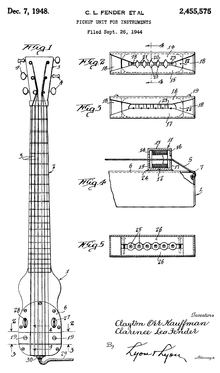
The company began as Fender's Radio Service in late 1938 in Fullerton, California. It got its name from the surname of its founder Leo Fender. As a qualified electronics technician, Leo Fender had been asked to repair not only radios, but phonograph players, home audio amplifiers, public address systems and musical instrument amplifiers. (At the time, most of these were just variations on a few simple vacuum-tube circuits.) All designs were based on research developed and released to the public domain by Western Electric in the 1930s and used vacuum tubes for amplification. The business also sidelined in carrying records for sale and the rental of self-designed PA systems. Leo became intrigued by design flaws in contemporary musical instrument amplifiers and began building amplifiers based on his own designs or modifications to designs.
By the early 1940s he had partnered with local electronics enthusiast Clayton Orr "Doc" Kauffman and together they formed the company K & F Manufacturing Corp to design, manufacture, and market electric instruments and amplifiers. Production began in 1945 with Hawaiian lap steel guitars (incorporating a patented pickup) and amplifiers sold as sets. By the end of the year Fender became convinced that manufacturing was more profitable than repair and he decided to concentrate on that business instead. Kauffman however remained unconvinced and he and Fender amicably parted ways by early 1946. At that point Leo renamed the company the Fender Electric Instrument Company. The service shop remained open until 1951, although Leo Fender did not personally supervise it after 1947.
A custom lap steel guitar made in 1946 for his friend Noel Boggs was probably the very first product of the new company, already sporting the familiar Big "F" logo.[9]
Fender owed its early success not only to its founder and talented associates such as musician/product engineer Freddie Tavares but also to the efforts of sales chief, senior partner and marketing genius Don Randall. According to The Stratocaster Chronicles (a book by Tom Wheeler; Hal Leonard Pub., Milwaukee, WI; 2004, p. 108), Randall assembled what Fender's original partner Doc Kauffman called "a sales distributorship like nobody had ever seen in the world." Randall worked closely with the immensely talented photographer/designer, Bob Perine. Their catalogs and ads were innovative - such as the "You Won't Part With Yours Either" campaign, which portrayed people surfing, skiing, skydiving, and climbing into jet planes, all while holding Jazzmasters and Stratocasters.
In Fender guitar literatures of the 1960s, attractive, guitar-toting teenagers were posed with surfboards and Perine's classic Thunderbird convertible at local beachside settings, firmly integrating Fender into the surfin’/hot rod/sports car culture of Southern California celebrated by the Beach Boys, beach movies, and surf music. (The Stratocaster Chronicles, by Tom Wheeler; Hal Leonard Pub., Milwaukee, WI; 2004, p. 108). This early success is dramatically illustrated by the growth of Fender's manufacturing capacity through the 1950s and 1960s.
Sale to CBS
In early 1965, Leo Fender sold his companies to the Columbia Broadcasting System (CBS) for $13 million.[10][11] This was almost two million more than they had paid for The New York Yankees a year before. CBS entered the musical instruments field by acquiring the Fender companies (Fender Sales, Inc., Fender Electric Instrument Company, Inc., Fender Acoustic Instrument Company, Inc., Fender-Rhodes, Inc., Terrafen, Inc., Clef-Tronix, Inc., Randall Publishing Co., Inc., and V.C. Squier Company), as well as Electro-Music Inc. (Leslie speakers), Rogers drums, Steinway pianos, Gemeinhardt flutes, Lyon & Healy harps, Rodgers (institutional) organs, and Gulbransen home organs.

This had far-reaching implications. The sale was taken as a positive development, considering CBS's ability to bring in money and personnel who acquired a large inventory of Fender parts and unassembled guitars that were assembled and put to market. However, the sale also led to a reduction of the quality of Fender's guitars while under the management of "cost-cutting" CBS. Several cosmetic changes occurred after 1965/1966, such as a larger headstock shape on certain guitars. Bound necks with block shaped position markers were introduced in 1966. A bolder black headstock logo, as well as a brushed aluminum face plate with blue or red labels (depending the model) for the guitar and bass amplifiers became standard features, starting in late 1968. These first "silverface" amps added an aluminium trim detail around the speaker baffle until 1970.
Other cosmetic changes included a new "tailless" Fender amp decal and a sparkling orange grillcloth on certain amplifiers in the mid-1970s. Regarding guitars, in mid-1971 the usual four-bolt neck joint was changed to one using only three bolts, and a second string tree for the two middle (G and D) strings was added in late 1972. These changes were said to have been made to save money: while it suited the new 'improved' micro-tilt adjustment of the neck (previously requiring neck removal and shimming), the "Bullet" truss rod system, and a 5-way pickup selector on most models, it also resulted in a greater propensity toward mechanical failure of the guitars.
During the CBS era, the company did introduce some new instrument and amplifier designs. The Fender Starcaster was particularly unusual because of its shallow, yet completely hollow body design that still retained the traditional Fender bolt-on neck, albeit with a completely different headstock. The Starcaster also incorporated a new Humbucking pickup designed by Seth Lover, which became known as the Wide Range pickup. This pickup also gave rise to 3 new incarnations of the classic Telecaster: the Telecaster Custom, the Telecaster Deluxe and the Telecaster Thineline. Though more recent use by Jonny Greenwood of Radiohead has raised the Starcaster's profile, CBS-era instruments are generally much less coveted or collectable than the "pre-CBS" models created by Leo Fender prior to selling the Fender companies to CBS in 1965.
The culmination of the CBS "cost-cutting" may have occurred in 1983, when the Fender Stratocaster received a short-lived redesign lacking a second tone control and a bare-bones output jack, as well as redesigned single-coil pickups, active electronics, and three push-push buttons for pickup selection (Elite Series). Additionally, previous models such as the Swinger (also known as Musiclander) and Custom (also known as Maverick) were perceived by some musicians as little more than attempts to squeeze profits out of factory stock. The so-called "pre-CBS cult" refers to the popularity of Fenders made before the sale.
After selling the Fender company, Leo Fender founded Music Man in 1975, and later founded the G&L Musical Instruments company, which manufactures electric guitars and basses based on his later designs.
After CBS
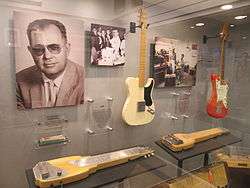
In 1985, in a campaign initiated by then CBS Musical Instruments division president William Schultz (1926–2006), the Fender Electric Instrument Manufacturing Company employees purchased the company from CBS and renamed it Fender Musical Instruments Corporation (FMIC). Behind the Fender name, FMIC has retained Fender's older models along with newer designs and concepts. The sale however did not include the old Fullerton factory; FMIC had to build a new facility in nearby Corona.
Fender manufactures its highest quality, most expensive guitars at its Corona factory in California and manufactures a variety of other mid-to-high quality guitars at its Ensenada factory in Baja California, Mexico. Channing Ward is the lead designer of the 2009 Stratocaster. Fender also contracts Asian guitar builders to manufacture Fender guitars and the economy priced entry-level Squier guitars.
In 1991, FMIC moved its corporate headquarters from its Corona location to Scottsdale, Arizona. Currently, this is where "administration, marketing, advertising, sales and export operations" take place, not only for the United States operations, but many other countries also.[12] Older vintage and U.S. built Fender guitars are generally the most favored, but pre-1990 Fender Japan guitars are now highly regarded as well. Fender guitars built in Ensenada, Mexico now fulfill the primary export role formerly held by Japanese-made Fenders. The Japanese Fenders are now manufactured specifically for the Japanese market, with only a small number marked for export.
On February 11, 1994, the Fender manufacturing plant based in Ensenada, Mexico burned down. Fender President Bill Shultz decided to temporarily move production from the Mexico plant to the U.S. plant. These Fender guitars are fairly rare and can be identified by the unique serial number.
In recent years, FMIC has branched out into making and selling steel-string acoustic guitars, and has purchased a number of other instrument firms, including the Guild Guitar Company, the Sunn Amplifier Company, and other brands such as SWR Sound Corporation. In early 2003, FMIC made a deal with Gretsch and began manufacturing and distributing new Gretsch guitars. Fender also owns: Jackson, Olympia, Orpheum, Tacoma Guitars (based in Seattle, WA), Squier and Brand X amps. In 2007, Fender acquired Kaman Music Corporation, which owns Ovation Guitar Company, Latin Percussion and Toca hand percussion products, Gibraltar Hardware, Genz Benz Amplification, Charvel, Hamer Guitars and is the exclusive U.S. sales representative for Sabian Cymbals and exclusive worldwide distributor of Takamine Guitars and Gretsch Drums.
In February 2007, Fender announced that it would produce an illustrated product guide in place of its traditional annual Frontline magazine. They made this change in large part due to costs associated with paying royalties for both print and the Internet. With the new illustrated product guide, this removed print issues. The new guide contains the entire range of instruments and amplifiers, with color pictures and basic specifications. The New Fender Frontline In-Home is produced during the year, keeping customers up to date with new products. These are available through guitar publications and are directly mailed to customers who sign up on the Fender website. As well as these printed formats, Fender Frontline Live launched at the winter NAMM show in January 2007 as a new online reference point, containing information on new products and live footage from the show.
On October 28, 2007, Fender announced its intention to buy Kaman Music Corporation (owners of Hamer Guitars, and Genz Benz amplifiers, along with many others, and exclusive distributor for Sabian cymbals and Takamine Guitars). Other Fender instruments include the Mustang, Jazzmaster, Jaguar, Starcaster, Duo-Sonic, Toronado and Bronco guitars; basses such as the Jazz Bass, the 'Telecaster Bass' reissue of the original 1950s Precision Bass; a line of lap steels; three models of electric violin, and the Fender Rhodes electric piano.
In 2011, Volkswagen partnered with Fender Corporation to manufacture premium sound systems for its vehicles in North America, under the direction of Panasonic. Volkswagen vehicles in North America that offer optional Fender Premium Sound are the Volkswagen Golf, Volkswagen Beetle, Volkswagen Jetta Sedan, Volkswagen Passat, and Volkswagen Tiguan.
As of July 10, 2012, the majority shareholders of Fender were the private equity firm of Weston Presidio (43%), Servco Pacific (5%) and the Japanese music distributors Yamano Music (14%) and Kanda Shokai (13%).[13][14] By December 2012, TPG Growth (the middle market and growth equity investment platform of TPG Capital) and Servco Pacific took control of the company after acquiring the shares held by Weston Presidio.[15]
In February 2015, KMC was sold to Jam Industries[16] by Fender Musical Instruments Corporation[17]
Products
The core of its instrument line — the Telecaster, Stratocaster, Jaguar, Jazzmaster, Mustang, Precision Bass and Jazz Bass — remains largely unchanged from the 1950s and 1960s originals[18] Fender's Telecaster — produced since 1950 and originally called the Broadcaster[19] — includes several editions: American B-Bender, American Deluxe, American Special, American Standard, American Vintage, Artist, Blacktop, Cabronita, Classic, Classic Player, Deluxe, Factory Special Run, Fender Select, Limited Anniversary Edition, Modern Player, Roadworn, Special Edition, Standard, Tele-bration and Vintage Hot Rod. The Stratocaster range — produced since 1954 — would likewise expand to include from many editions: Standard, Modern Player, Deluxe, American Standard, American Deluxe, American Vintage, Classic, Classic Player, Vintage Hot Rod, Blacktop, Highway 1, American Special, Roadworn, Ultra, Artist, Fender Select and Pawn Shop.
Electric guitars
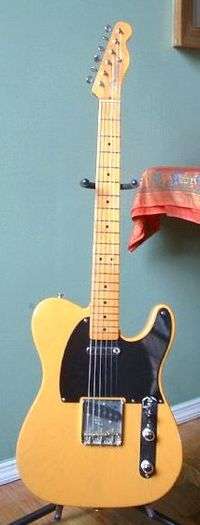 Telecaster,
Telecaster,
introduced 1950 Stratocaster,
Stratocaster,
introduced 1954 Jazzmaster,
Jazzmaster,
introduced 1958.jpg)
.png) Mustang,
Mustang,
introduced 1964
Acoustic guitars
 Malibu,
Malibu,
introduced 1965[21] DG-4TS,
DG-4TS,
introduced 1996[22] Stratacoustic
Stratacoustic FR48 resonator,
FR48 resonator,
introduced 2003[23]
Electric basses
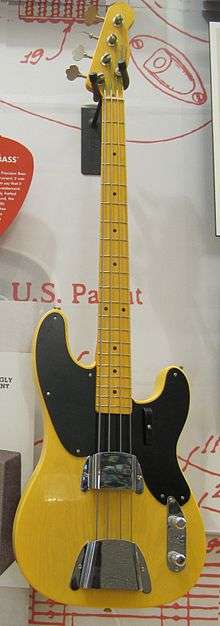 Precision Bass,
Precision Bass,
introduced 1951 Precision Bass,
Precision Bass,
reissue of 1957 model Jazz Bass,
Jazz Bass,
introduced 1960 Mustang Bass,
Mustang Bass,
introduced 1966 Jaguar Bass,
Jaguar Bass,
introduced 2006
Amplifiers
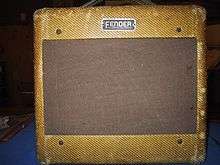
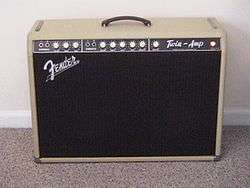
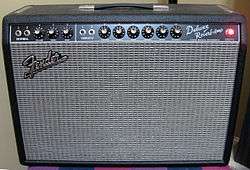
After the early models released in 1946 (called "woodies" for their uncovered wooden cabinets), the first big series of amplifiers were built in 1948. These were known as Tweed amps because they were covered in the same kind of cloth used for luggage at the time. At first the cabinets had relatively small round-cornered speaker apertures, known as "TV fronts;" they were replaced in 1953 by top and bottom "wide-panels" and those in 1955 by the "narrow-panels." The original tweed amp lineup comprised the Champion/Champ, Princeton, Deluxe, Professional/Pro and Super. The Fifties saw the addition of the Bassman (1952), Bandmaster and Twin (1953), Tremolux and Harvard (1955) and Vibrolux (1956).
The Champ had the lowest power output and simplest circuit of all Fender tube amps. The Champ had only one power tube. Fender marketed it as a student and practice amp, but its three or four watts and the simple, good-sounding circuit made the Champ popular in recording studios. At the other end of the range, the Twin came to use four 6L6 or 5881 power tubes to produce 50, and later a huge (for the time) 75 watts.
This was an innovative period. Leo Fender made a Tweed Princeton in 1948 for his short-lived Professional 8-string lap steel, which amounted to a Champ with a tone knob. By 1960, the Princeton was a push–pull class-AB amplifier. In this era Fender experimented with different amplifier designs—cathode vs. fixed bias, paraphase vs. cathodyne vs. long-tailed pair phase inverters, octal vs. 9-pin preamp tubes, feedback loops and filter chokes. The tweed era also saw Fender's first amps with tremolo, the Vibrolux and Tremolux—and the advent of hi-lo and "bright" inputs.
The Bassman was a bass amplifier introduced by Fender in 1952 to accompany the new Precision Bass. Although it was originally intended for amplifying bass guitars, the Bassman was also used for non-bass electric guitar & pedal steel guitar amplification.[24] During 1952, the Bassman was introduced as a combo amp with one fifteen inch speaker (1x15),[25] but in 1955 acquired its classic 4x10" speaker configuration.
In 1959-60 Fender moved to Tolex coverings for the new "brownface" amps, so called for their brown, front-mounted control panels. They produced blonde and brown amplifiers between 1960 and 1964, with a comprehensive redesign of circuitry, cabinets and control layouts. During this era, Fender introduced the Concert, Vibrasonic, Showman, and Vibroverb—and a completely new Princeton.[26]
The blonde amps included all the new head-and-cab piggyback Fender amps (the Tremolux, Bassman, Showman, and Bandmaster)—and a few combo amps, including the top-of-the-line Vibrasonic Most combos were brown, except for later Twins, which Fender changed from brown to blonde in 1961, and the Champ, which kept its tweed until 1964.[27] They featured two colors of grill cloths—oxblood and wheat.[28] The brownface generation included tremolo circuits on most models, and introduced spring reverb as a separate unit and in the Vibroverb. Fender also began using Oxford, Utah, and CTS speakers interchangeably with the Jensens. Jensens and Oxfords remained the most common during this period. Generally, they used the speaker they could get most economically.[29]
By late 1963, some Fender amplifiers moved to blackface cosmetics. Other 1963 model amps—particularly the Vibroverb (the first Fender amp featuring internal reverb)—remained brown. The amps still spanned the spectrum from 4 watts to 85, but the difference in volume was larger, due to the improved, clean tone of the 85w Twin.
Fender produced the Blackface Fender amplifiers between 1964 and 1967. They had a black Tolex covering, silver grille cloth, and black control panel. The first piggyback blackface amps (as well as the Princeton) had white knobs. After 1964 the amps had skirted black knobs.
By 1964, Fender changed the tremolo from the complex "harmonic vibrato" to a simpler and less expensive circuit based on an optical coupler, which required only half of one 12AX7 twin triode tube. Also in the blackface era, they added internal-reverb versions of several popular amps—including the Princeton Reverb, Deluxe Reverb, Super Reverb, Pro Reverb, Twin Reverb, and Showman Reverb. Fender discontinued the blackface cosmetics in late 1967. They brought them back for a brief period in 1981, and discontinued them again the following year. Recently, Randall Smith of Mesa/Boogie Amplifiers noted that Blackface amps were "cleaner sounding" than previous versions, which inspired him to make "dirtier sounding" amps.[30]
Also in 1964, Fender issued a black Tolex "tweed" Champ in black tolex in small numbers, along with the newer true blackface model with the slant front panel and controls. The stacked cabinet boxes Leo Fender used often went uninventoried. In late 1963, Leo Fender also found a couple of hundred unused Tweed Champ chassis; he had had them chromed and printed in 1958. Being frugal, he built them in black tolex with a chrome and black Champ nameplate, as he had money tied up in them already.
Blackface cosmetics do not necessarily mean "pre-CBS" since the CBS company takeover took place, in a legal sense, on January 4, 1965—and the company made amps with blackface cosmetics up to 1967. After the buyout, Fender changed the front panels from Fender Electric Instrument Co. to Fender Musical Instruments. They made few substantial changes to the amps until the Silverface amps of 1968, where certain circuit changes made them less desirable than the blackface amps.
Nevertheless, amplifier repair technicians have observed a general slip in production quality of amps produced in the 1966-68 era—particularly in chassis lead dress and other subtle electronic details. The silverface redesigns affected some models more than others. For example, the Twin Reverb and Super Reverb combos, along with the Dual Showman Reverb and Bandmaster Reverb "piggyback" heads were equipped with a master volume control. Other models, such as the Deluxe Reverb, were not altered except for the cosmetic changes.
Custom Shop
The Fender Custom Shop produces special-order guitars for customers through a Custom Shop dealer network, creates limited edition guitars, builds limited edition amplifiers, and does some research & design for the parent company.
Squier
Squier was a string manufacturer that Fender acquired. Fender had used the Squier brand since 1982 to market inexpensive variants of Fender guitars to compete with Stratocaster copies, as the Stratocaster became more popular. Squier guitars have been manufactured in Japan, Korea, Mexico, India, Indonesia, China, and the United States.
The Fender Visitor Center and Factory Tour

The Fender company is currently based in Corona, California, about an hour’s drive from Los Angeles and not far from its Fullerton origins. This location has been a working factory since 1998 and manufactures about 400 guitars a day. They offer hour-long factory tours to the public twice daily for a small fee.[31]
The Visitor Center functions as a small museum, full of displays related to the history of the company, photos and a biography of Clarence Leonidas "Leo" Fender and displays of Fender instruments and the musicians who played them. The actual guided tour leads participants through the working factory where they view construction of guitars from the pickup fabrication process to the Woodmill room, where workers cut Fender guitar bodies and necks from planks of wood. Tour groups then view the Sanding Room where guitars are sanded and shaped, the Buff and Polish Room where the paint job is finalized, the Final Assembly area where the guitar's hardware is added, and the Inspection/End of the Line room where the guitars are tested.[32]
Associated artists
Many rock, country and jazz musicians have used Fender guitars from 1951 to the present. Some notable Fender players, both past and present, include Muddy Waters, Jim Adkins, Jeff Beck, Ritchie Blackmore, Roy Buchanan, Eric Clapton, Albert Collins, Billy Corgan, Robert Cray, Steve Cropper, Kurt Cobain, Bob Dylan, Rory Gallagher, David Gilmour, Janick Gers, Buddy Guy, George Harrison, Jimi Hendrix, Buddy Holly, Eric Johnson, Mark Knopfler, Scott Lucas, Yngwie Malmsteen, Johnny Marr, Hank Marvin, John Mayer, Paul McCartney, Dave Murray, Jimmy Page, Nigel Pulsford, Keith Richards, Nile Rodgers, Jim Root, Gavin Rossdale, Kenny Wayne Shepherd, Chris Shiflett, Bruce Springsteen, Pete Townshend, Robin Trower, Stevie Ray Vaughan, Brian Wilson, and many others.
Bass players favoring Fender instruments have included Geezer Butler, Adam Clayton, Bill Dickens, Mike Dirnt, Flea, Steve Harris, Mark Hoppus, James Jamerson, John Paul Jones, Geddy Lee, Duff McKagan, Nate Mendel, Jaco Pastorius, Dave Parsons, Jeff Pilson, Dee Dee Ramone, Troy Sanders, Rudy Sarzo, Robert Trujillo, Roger Waters, John Entwistle, and many others.
See also
References
- ↑ "Fender Musical Instruments Corporation Appoints Andy Mooney to CEO". 2 June 2015. Retrieved 3 June 2015.
- ↑ http://spotlight.fender.com/newsroom/news/490/
- ↑ About Fender - Official Fender Website, 5 May 2015
- ↑ O'Toole, James (2012-03-08). "Guitar-maker Fender files for IPO - Mar. 8, 2012". Money.cnn.com. Retrieved 2014-03-15.
- ↑ http://www.forbes.com/sites/benzingainsights/2012/07/20/fender-withdraws-ipo/
- ↑ http://fortune.com/2012/07/20/why-fender-pulled-its-ipo/
- ↑ Hennigan, W.J. (March 8, 2012). "Guitar maker Fender files for initial public offering". Los Angeles Times. Retrieved 2012-03-08.
- ↑ "Broadcaster Guitar Development". Britannica. 2008. Retrieved 2008-08-31.
- ↑ http://www.well.com/~wellvis/boggs.html
- ↑ "CBS Acquires Guitar Concern. Purchases Fender Co. for $13 Million in Cash Deal". New York Times. January 5, 1965. Retrieved 2012-08-23.
The Columbia Broadcasting System, Inc., which entered the sports field by acquiring the New York Yankees, is further diversifying into the guitar and amplifier manufacturing business.
- ↑ Day, Paul (1979). The Burns Book. pp Publishing. p. 36.
- ↑ "About Fender Musical Instruments Corporation". 2014. Retrieved 2014-09-22.
- ↑ "Amendment No. 6 to FORM S-1 Registration Statement - Fender Musical Instruments Corporation". Washington, D.C.: United States Securities and Exchange Commission. July 10, 2012. p. 146. Registration No. 333-179978.
- ↑ "Fender changes tune on IPO". The Orange County Register. Associated Press. July 21, 2012. p. Business 3.
- ↑ https://www.pehub.com/2013/09/with-control-tpg-growth-servco-make-fender-consumer-friendly/
- ↑ "FMIC Sells KMC Music Wholesale Distribution Business to JAM Industries". Music Inc. Magazine. February 12, 2015.
Fender Musical Instruments Corporation (FMIC) announced on Feb. 10 that it has completed an asset sale of the KMC Music wholesale distribution business, including the trade name B &J Music, and certain proprietary brands, to JAM Industries, Ltd. JAM Industries is a global leader in the MI, pro-audio and consumer electronics wholesale distribution business.
- ↑ "Fender Musical Instruments Corp: General form for registration of securities under the Securities Act of 1933: List of Subsidiaries" (Type: EX-21.1; Act: 33). EDGAR. U.S. Securities and Exchange Commission. 2012-03-08. Acc-no: 0001193125-12-101896 (33 Act), File No: 333-179978, CIK#: 0000767959.
KMC Music, Inc. dba KMC Musicorp., CT / •KMI Europe, Inc., DE / •B & J Music Ltd., Canada / •Takamine Gakki Co., Ltd. (12% KMC Music, Inc.), Japan
- ↑ Roberts, Jim (2003). American Basses: An Illustrated History and Player's Guide.
- ↑ Duchossoir, A. R. (1991). The Fender Telecaster: The Detailed Story of America's Senior Solid Body Electric Guitar. Milwaukee: Hal Leonard Publishing Co. ISBN 0-7935-0860-6.
- ↑ "Fender Vintage Guitars - Collector Information / Collectors Weekly". Collectors Weekly (online version). Market Street Media LLC. Retrieved 2016-02-02.
- ↑ Fender website: Early U.S.-made Fender Acoustic Guitars
- ↑ Fender website: DG Series: Fender Acoustic Guitars imported from China, Indonesia and Korea
- ↑ Fender website: DG Series: Fender Acoustic Guitars imported from China, Indonesia and Korea
- ↑ The Bassman was so popular as a guitar amp that Jim Marshall would essentially copy it, adapted to British tubes, to create his legendary JTM-45
- ↑ "Fender Wide Panel Tweed Bassman". Ampwares. Retrieved 2014-03-15.
- ↑ This Princeton circuit, which remained essentially unchanged through the 60s and 70s except for a simplified tremolo circuit, was the basis for the hot-rodded Mesa Boogie Mark I.
- ↑ 1962-63 also saw the brief production of another tweed holdover, the rare 6G10 Harvard. This amp, long thought to exist only as a circuit diagram, was a way for the frugal Fender to use up leftover tweed Harvard and Princeton cabinets and Princeton chassis
- ↑ Fender made several experimental tweed amps in blonde. While they made the majority of piggybacks in blonde Tolex, there are a few examples of brown Tolex Bassman amplifiers.
- ↑ The high-end Showman and Vibrasonic, however, featured premium JBL speakers.
- ↑ "Mesa Boogie Limited Edition King Snake - Carlos & Randy 2013". Youtube.com. Retrieved 2014-03-15.
- ↑ Kreuzer, Nikki, "Best Guitar Factory Tour 2013- Fender Factory Tour", "LA Weekly", October 4, 2013, p 121.
- ↑ Kreuzer, Nikki, "Offbeat L.A.: The Fender Guitar Factory Tour","The Los Angeles Beat", March 13, 2013.
External links
| Wikimedia Commons has media related to Fender. |
- Fender Musical Instruments official website
- Leo Fender Exhibit, Permanent exhibit at the Fullerton Museum on the Fender company history in the city
- NAMM Oral History Interview with William Schultz (2000)
- NAMM Oral History Interview with Bill Mandello (2010)
- NAMM Oral History Interview with Larry Thomas (2012)